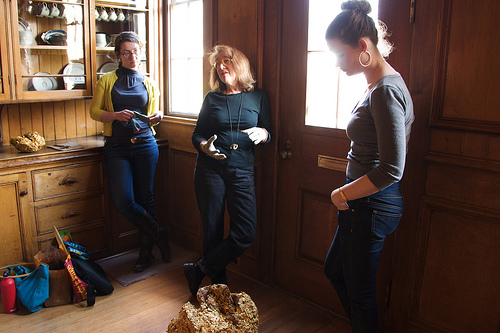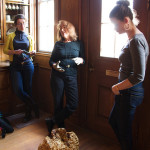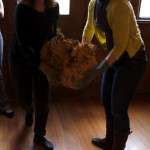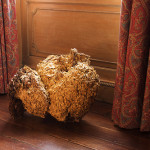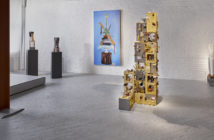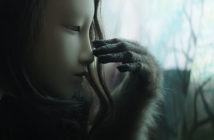Last April I went to an art exhibit at Brown University's Nightingale-Brown House. The building houses the John Nicholas Brown Center's masters degree program in Public Humanities, and though a federally-qualified historic landmark, seemed like a good place for an art installation to a couple of its students - now graduates - who are former curators of Roxbury's Berwick Research Institute. The BRI is known for its experimental curatorial approach, which the students and show's curators, Meg Rotzel and Rosie Branson Gill, largely designed.
Art+History, as they titled the exhibition, was comprised of the commissioned works of California-based photographer Carla Herrara-Prats and Massachusetts-based sculptor Jill Slosburg-Ackerman. Both artists created works specifically for the show, based on what they could find in the house. They both toyed with the tension between investigation and imagination of writing "history," foregrounding the ambiguities of narrating the past and attempting to find new ways to connect history with the present. Herrara-Prats instigated new explorations of the past with photographs and recordings in her multi-part installation, Keep the word vanishing until the end, while Slosburg-Ackerman assembled and stacked-together several allegorical sculptures from objects found on and off-site in a series titled IMPORT-EXPORT. One of Slosburg-Ackerman's works, however, stuck out from the rest, yet none of the writing and criticism on the exhibition has mentioned it (including a wonderful review of Art+History in Big RED).
It was titled IMPORT-EXPORT remains and consisted only of wood chips, saw dust and wood glue. It was shapeless, visually ugly and heavy enough to require two bodies to move it. From a few yards away, it resembled a large cooked turkey that had slipped out of a cook's hands and landed awkwardly or an electron microscope image of a termite turd. It may have been for its remarkably uncompelling nature that the work was overlooked, but its abstruseness as an artwork, in a show that's already quite complex, may have been simply too intimidating.
But I've had six months to think about it.
When discussing the show and its setting in a house museum, Rotzel said the pieces of furniture in the house have been situated as "the past," when in fact they are merely assembled objects. Essentially, we've assigned values to those objects based only on their historical significance to us and the institutions that preserve them. She said the exhibition was not about the linear narrative we think of as history, but about the interpretation of the past: how do people look at the past and how do they structure it in order to serve their purposes. Archivists and historians make "history" when they write their books and create their museums.
Art+History endeavored to have artists make art by using the past. All of Slosburg-Ackerman's works, except for "remains," were acutely tuned to the context of the house and many seemed camouflaged within its furnishings and decorations. Slosburg-Ackerman had carved a chunks and layers off of many of her wood-based objects to imply the removal of "historical" veneers or the chipping away of history to reveal the past. The wood she revealed was, in fact, much older than the finish that coated many of her found objects and the layers now evident produced an entirely new object.
After all the carving, Slosburg-Ackerman was left with a large pile of saw-dust and wood chips, and each little bit had its historical significance, hence its title, "remains". But what do you do with such an unbecoming and bulbous metaphor? The curators, staff and the sculptor herself wrangled with the object's nothingness; its contents were an amalgamation of the entire exhibition, but the object itself sat mysteriously between object d'art and dirt. It's apparently even difficult to photograph such a shear blob of unqualifiable insignificance (or utter significance?). The exhibition photographer eventually decided on multiple pictures of the object (all of which are available in the show's flickr site ( link below), and though remains is the obvious subject of each photo, the composition of each shot is aided by the architecture of the house: floorboards, wainscoting and curtains.
The work was eventually given its own space inside the pantry and came last in the installation process. At first the work rested 10 inches from the wall, but after a weekend of thinking about it, Slosburg-Ackerman thought it looked too much like a sculpture; to her, its placement was too heavy-handed. She and the curators then decided to push it against the wall because it had a relationship with the room's architecture and the wood of the floor and wall: the history of the house.
- Jessie, Jill Slosburg-Ackerman’s assistant, Slosburg-Ackerman and curator Meg Rotzel discuss what to do with IMPORT-EXPORT remains.
- Slosburg-Ackerman and her assistant moving IMPORT-EXPORT remains, though probably not for the last time that day.
- Jill Slosburg-Ackerman, IMPORT-EXPORT remains (getting closer to the work’s final location for its installation), wood chips, saw dust, wood glue, 2009.
John Nicholas Brown Center, Brown University
John Nicholas Brown Center for Public Humanities and Cultural Heritage M.A. program in Public Humanities
Brown University's Nightingale-Brown House
Jill Slosburg-Ackerman's website
Carla Herrara-Prats's website
All images are courtesy of the artist, Jill Slosburg-Ackerman, and photographer, Nara Hernandez.
Art+History - Flickr
"Art+History" is on view through October 17, 2009.

